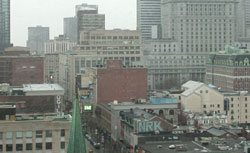Interactive HD images travel

Despite inclement weather, viewers at the Ontario College of Art and Design were able to watch a 72-hour live interactive high-density image transmission originating from the Hexagram facilities in the EV Building.
courtesy Paul fournier
Transmitting high definition real-time images may actually be possible in the short-term, making the global village just that much more immediate and allowing synchronized interaction over vast distances.
Researchers at the Ontario College of Art and Design (OCAD) were able to watch the Montreal skyline from the west-facing windows of Hexagram’s laboratory high within the EV Building for 72 hours straight earlier this month.
“This is video-conferencing at the next level,” said Lynn Hughes, the Fine Arts Faculty’s Associate Dean of Academic Affairs. “There is going to be increasing demand to do this kind of transmission.”
The experiment, which also involved Simon Fraser University, is a ground floor exploration of the capability of high definition interactive image transmission that will allow universities to exchange material, teach master classes and even perform virtually in real time from locations across country.
Hexagram has been exploring the potential of this type of collaboration for quite some time. Steve Bush, Assistant Director of Technical Systems and Services at IITS, and Paul Fournier at Hexagram figured out the technical requirements for this experiment using the Réseau d'informations scientifiques du Québec (RISQ) network.
The experiment sent an intermittently degraded signal when the transmission hit the ceiling of the current allowable bandwidth out of the university. IITS has set a cap on outgoing traffic because higher volume translates into higher costs. “That is the biggest block for Concordia right now, but it is not common to the other institutions,” Fournier said. The cap is supposed to be lifted.
Fournier said that the real challenge is reconciling the relationship between high definition images and latency or time delays. Technically speaking, the sharper the image, the greater the delay to transmit it. That is not a problem for transmitting static cityscapes, but would be an issue for attempting concerts with musicians in different locations. More evaluation of both the encoding and the protocols used for the videostream are necessary to resolve this issue.
Given that the university could ideally benefit from multiple streams for different purposes, these network problems need to be addressed. “Currently, the RISQ network could not support the kind of multicast we would like to do,” said Fournier.
“We need to be pushing the internal and bureaucratic limits,” said Hughes.
Plans are in the works to expand the experiment to seven institutions for another attempt in the fall.